skip to main |
skip to sidebar
I'm BAAAAAAAAAAACK! At least for today. This recipe is more for the salad dressing than the salad itself. You can use whatever salad vegetables you like, that you would eat raw. Mine had shredded carrots and beetroot, rocket (arugula), baby spinach, some lettuce of the red-veined variety (who knows what it's called!), tomato wedges, cucumber slices and of course boiled eggs.
Oh, and please ignore the rather gruesome grey-green ring around the yolks. I'm usually pretty deft at getting a perfectly yellow-yolk in my boiled egg, but it so happened that I completely forgot that I had eggs simmering away on the hob. I was distracted by a Facebook status and got sucked in, as you do. I don't know about you, but I blame Mark Zuckerberg. I was loath to throw the eggs away for this blemish and, besides, the green-ringed yolks aren't harmful to eat. So there you have it. By the way, the dressing works rather well with the eggs. I wouldn't have thought it, to be fair.
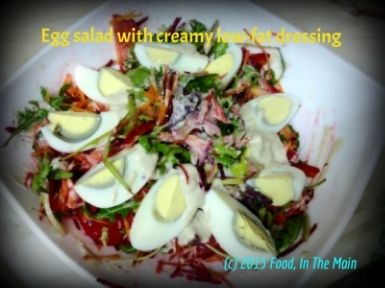
Recipe for: Egg salad with creamy salad dressing
Ingredients
For the salad dressing:
1 tbsp low-fat mayonnaise
4 tbsp Greek or natural yogurt (not sour)
1 htbsp grated parmesan cheese
1.5 tsp Worcestershire sauce
1 tsp lime juice
1 small garlic clove, grated
Freshly ground pepper
pinch of salt
pinch of smoked paprika
For the salad:
1 cup shredded carrots
1/2 cup shredded beetroot
2 medium tomatoes, quartered OR 10-15 cherry tomatoes, halved
1/2 cup cucumber slices
Generous mixture of salad leaves as desired
4 boiled eggs, peeled and quartered
Method:
1. Whisk all the ingredients for the dressing in a bowl. Thin it with a little water, whisking it in, until the dressing is thick but pourable. Adjust the ingredients as required till it tastes good to you. Chill the dressing until required.
2. Put all the salad ingredients in a large bowl and toss them together until evenly distributed. Just before serving, divide the contents between two bowls and dollop most of the dressing over. Mix it into the salad lightly and carefully with your hands fingers or using salad "hands". Place the quartered eggs on top, dab with the remaining dressing and serve at once.
I’ve been wanting to make tomato soup from scratch for the longest time – actually for the last 20 years or so, ever since a very dear friend, A, described in detail the tomato soup that he made at home. This guy, a dedicated cook and an even more dedicated foodie who had traveled extensively on his stomach (not literally), was also blessed with the gift of the gab.
His description of the cooking process, and the taste of the finished product, had me riveted, and when I finally turned my attention back to the tomato soup that I had ordered (we were having lunch at the Mathura Restaurant in Madras), it had morphed into tomato ketchup diluted with water. Strange, that, because until that point I had loved their tomato soup and ordered it pretty much every time I went there. (Another friend of mine religiously had the French onion soup every single time – now there’s a completely true and completely useless fact for your collection, folks.)
Anyhow, since it was A’s fault that the Mathura tomato soup (with four croutons, no less) had been ruined for me forever, he promised to treat me to his home-made specialty – an occasion that never did materialise for one reason or another, as is wont to happen.
But he is more than aware that he owes me (because I keep reminding him), and at some point when I make a trip to Vancouver, he knows he will have to make good.
The point is, ever since that occasion, home-made tomato soup has always seemed the aspirational apex of home comfort food to me, even though we were not big on soup in my family, really – it was mostly an eating-out thing with us, not made at home. Still, that impression about tomato soup stayed with me over the years, although I never got around to making it myself even after I got interested in cooking... partly because it was so tied-in with A and his promise (something like if I was going to have home-made tomato soup, it was going to be HIS soup or nothing at all).
Luckily, stupidity of even that intensity has an expiry date, and after I’d read a few recipes for tomato soup – not just plain ol’ tomato soup, but roasted tomato soup - I finally twigged to the fact that I might be able to make it myself. Once that realization sank in, it took hardly any time to get around from thought to action. (Well, compare it with the pace of evolution and you’ll see how quick I was. Evolution took Nature millions of years. It only took me four.)
Recipe for: Garlicky roasted tomato soup
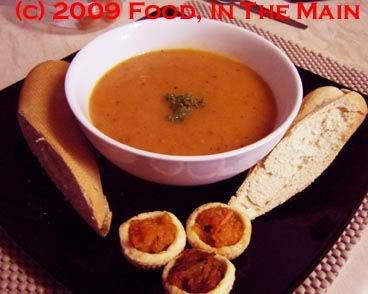
5 ripe medium-size plum tomatoes, quartered
1 medium red bell pepper, seeded and quartered
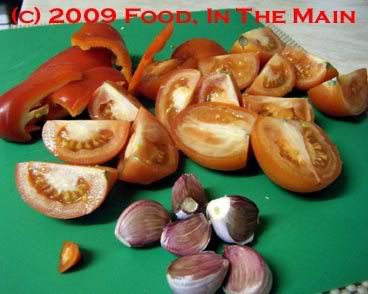
1/4 red scotch bonnet chilli, de-seeded (or use any milder chilli to taste)
5-6 large garlic cloves (unpeeled)
4 medium shallots, halved
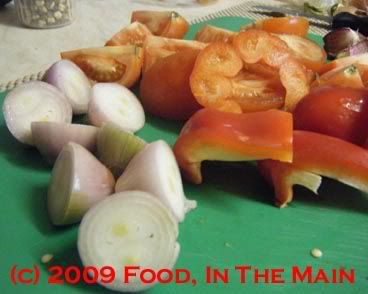
3-4 cups vegetable stock
Coarse sea salt (optional) 1/4 tsp regular paprika powder
Large pinch of smoked paprika powder
1/4 cup full-fat milk/cream
3-4 generous tbsp olive oil
Plenty of fresh coarsely-ground black peppercorns to taste
Method:
1. Pre-heat the oven to 200C. Line a shallow baking tray with foil and grease it with olive oil.
2. Mix together the tomatoes, shallots, peppers, chilli and garlic in a bowl along with the 4-5 tbsp olive oil,
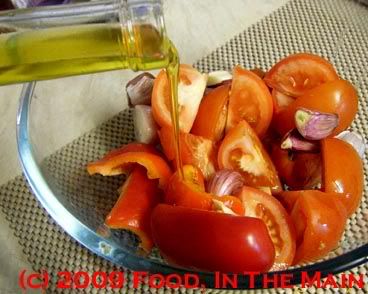
about 1 tsp of the sea salt
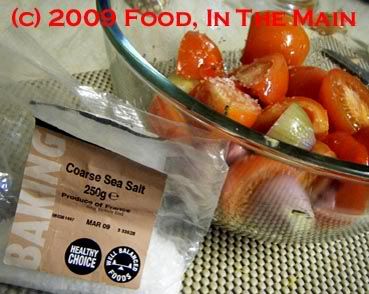
and about 1 tbsp coarse-ground black pepper.
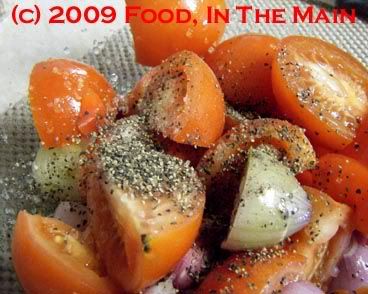
3. Pour the coated vegetables onto the greased tray
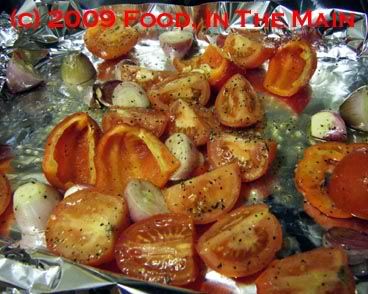
and bake in the oven for about 30 minutes, stirring them after 15 minutes

so as to let them brown evenly.
4. When the vegetable juices begin to caramelise and turn brown, and the tomatoes and onions are soft, turn off the oven.
5. Remove the garlic cloves and squeeze out the pulp into a blender along with the rest of the roasted veg.
6. If there is a lot of caramelized bits sticking to the foil, pour 2-3 tbsp boiling water on the bits and gently scrape with a plastic spatula. Pour the resulting liquidy bits into the blender as well.
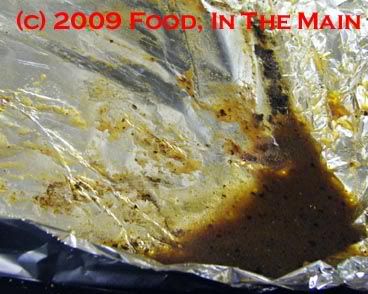
7. When sufficiently cool, add about a cupful of stock to the veg, then puree them to your preferred consistency - you can make it really smooth, or leave some chunky bits in. (I made mine fairly smooth.) Add more stock to the blender while pureeing, if required.
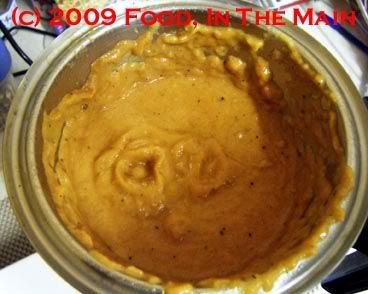
8. Mix the soup with the remaining stock in a saucepan and bring to a gentle simmer. Stir in the whole milk or cream if using,

the paprika, and simmer for 3-4 minutes. Check for seasoning, adding more freshly ground black pepper if required.
9. Serve hot in bowls with fresh crusty bread, toast or grilled sandwiches, topped with a little chopped parsley or basil for garnish.
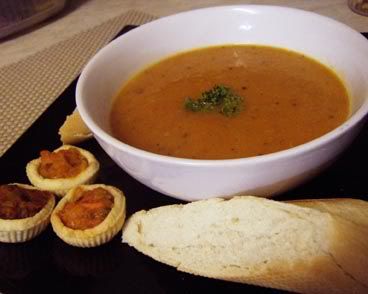
Up until now, kale had been a green that I bypassed almost automatically at the supermarket, although I always stopped to debate over whether to try it or not. Despite the bags advertising their contents as "tender curly leaf kale", my decision was always "not". Mainly because the sliced leaves looked so very tough, but also partly because, rightly or wrongly, I associated kale with Russian cooking from all the Russian folk tales and fairy tales that I'd read. It sure didnt seem like the most attractive vegetable... maybe more like poor man's fare.
Anyway, on the last shopping trip that I did with my mother and Hema, I threw in a bag of sliced kale, hoping to make something - anything - with it at some point. Days passed, my mother and cousin left, a week went by thereafter and still the kale sat in the little refrigerator in the shed (as opposed to the big one in the kitchen), almost but not quite forgotten. It didnt even have the grace to wilt or get soggy, like regular spinach does. It just stayed there, looking resilient and green and pretty much like it would be happy to sit there for as long as it wished.
So, last week I went trawling for kale recipes - I didnt want any Indian-style recipes this time, so it took a while to find something that seemed like it would taste interesting. Finally I came across a chorizo-chickpea-kale stew on Tamarind & Thyme, and since I had veggie sausages at hand, I decided to go with that. The recipe was pretty simple, really, and I was pleased to have smoked paprika at hand, as specified. What I didnt have was dry sherry, so I thought to use red wine - which also, unfortunately, I didnt have. So in the end, I used port (fortified wine). It seemed to work pretty well. I also reduced the amount of smoked paprika in the recipe, because I've discovered from experience that it can be VERY overpowering if not used sparingly. Again, I dont know if it's a quality of the particular kind of smoked paprika I have, or whether all smoked paprika tastes like that... but I was happy to go with just two pinches of it, rather than 1/2 tsp. That would have been wayyy too much.
After trying the stew, Pete thought that the kale was rather too strong a green for this recipe, although overall it was savoury and tasty. I liked it too, but I have to agree with him on this - despite my best efforts, the kale was still rather tough to the bite. Perhaps next time I'll use spinach, which we both love, and see how it works out.
I served the kale with another first - red quinoa, which I've never tried before. I found the seeds quite cute and I liked the white "ring" that appeared around their middle. Red quinoa has a funny taste by itself, but I'm sure it will lend itself to being combined with various things. As a matter of fact, I used leftover quinoa to make another dish - but that's for another post!
Maybe kale is best suited for Indian recipes incorporating dal and other vegetables. Time (an some more experimentation) will tell.
Recipe for: Veggie sausage, chickpea and kale stew
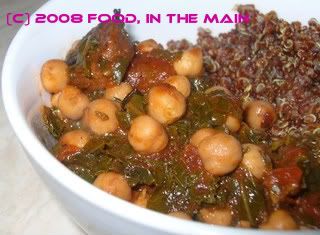
Ingredients:
1/2 cup vegetarian sausage, sliced 1 cm thick
1 medium onion, chopped
1 clove garlic, thinly sliced
2 tbsp olive oil
1 cup cooked chickpeas (canned is easiest)
2 cups kale, sliced
1/8 cup dry sherry (I used port)
1/2 cup chopped tomatoes (I used a small tin of crushed plum tomatoes)
½ tsp smoked paprika (I used 2 pinches)
½ cup water
Salt and freshly ground black pepper to taste
Method:
1. Heat a sauté pan over medium heat and pour in the olive oil.
2. Add the chopped onion and sauté till it begins to soften.
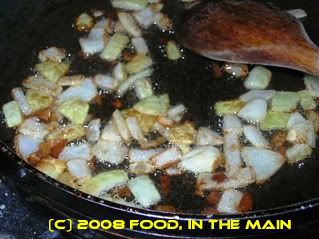
3. Add the sausage and continue frying until the sausage starts to crisp and the onions are golden.
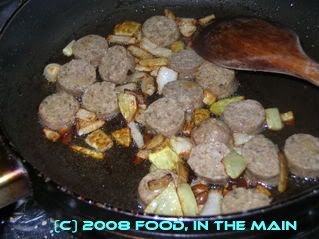
4. Add the garlic and let it sizzle for a minute (don’t let it burn).
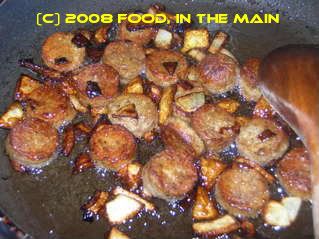
5. Add the dry sherry/port and let it bubble and then reduce.
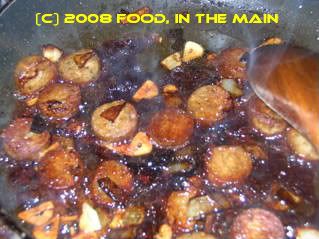
6. When the port has bubbled away almost completely, add the drained and rinsed chickpeas,
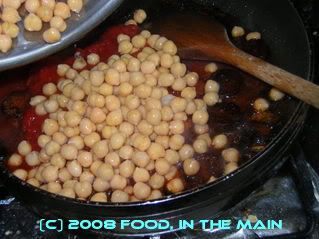
the chopped tomatoes and the paprika.
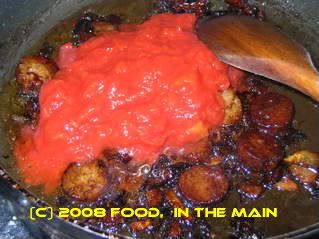
7. Mix it about for a couple of minutes, then add ½ cup water and let it simmer gently for 4-5 minutes.
8. Now toss in the kale, add ¼ cup water if the sauce looks too thick, cover the pan and let the kale steam.

9. Check every five minutes, giving the whole thing a stir, to see if the kale is done. If it’s not done to your liking, add a little more water, cover the pan and let it cook some more.

10. Add salt and pepper to taste, mix well,
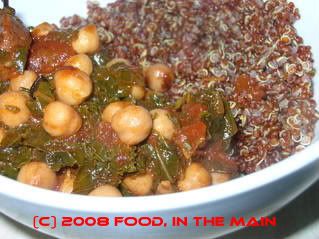
and serve hot with good bread, over rice or with quinoa (like I did).
Note: How to cook quinoa - Rinse the quinoa well under running water in a strainer with a fine mesh. If you try to rinse quinoa seeds in a regular pan, you will lose a lot of the little guys down the sink when you try to pour away the water. Trust me on this, this is the VoE (Voice of Experience) talking - quinoa seeds are VERY light, and float off quicker than you would imagine. The instructions on the quinoa packet dont tell you this - all it says is "rinse the quinoa 3-4 times". Hmph. (On my more paranoid days I tend to think that it's a ploy by the company to provide as little information as possible. That way, people using quinoa for the first time will have to buy another packet of the stuff sooner than they planned, after helplessly watching the washed seeds disappear down the plughole. Hey, this could even be true!)
1. Rinse 3/4 cup quinoa and drain.
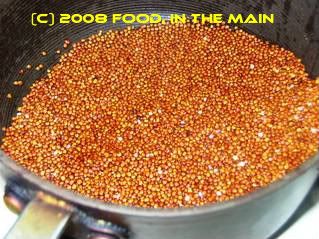
Roast it without oil in a pan until a few grains begin to pop.
2. Add 1-1/2 cups of water, bring to a boil, cover and simmer for about 15 minutes, or until the water is absorbed. The quinoa seeds will have a white "ring" around them when done.
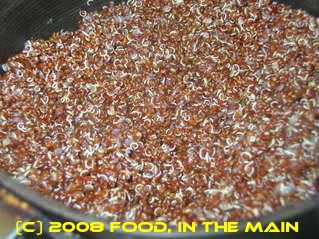
Remove from heat and let stand for 10 minutes. Fluff with a fork and let cool.
 Zarko, me, Pete and Ozana at the end of a long day, celebrating with the local sljivovitz
Zarko, me, Pete and Ozana at the end of a long day, celebrating with the local sljivovitz
Croatia – or the Slavonia region of the country – is Paradise for non-vegetarians. If you're an Indian non-vegetarian, the Slavonian cuisine will come as a pleasant surprise because it's fairly spicy from the paprika. In fact, Slavonian food is way, way spicier than anywhere else in Croatia and it owes a lot to Hungarian influences.
Talking about paprika, I have to say I'm quite confused now about what exactly paprika is. My friend Ozana called everything paprika – and that included bell peppers, long thin red chillies, long green chillies (which I consider typically Indian) and what looked like light green, long Mediterranean sweet peppers… but they were HOT when bitten into raw! And paprika also referred to the red powder that's famously from Hungary but is a staple in Croatia too.
Anyway, a typical meal that we had in Osijek started with a large platter of appetisers – slices of kulen (a spicy sausage flavoured with – yes, paprika), dry cured bacon, ham and 2-3 types of cheese, along with a cottage-cheese-and-chopped onion "salad", green olives (sometimes stuffed with – yes, ham) and thick slices of granary, black and white breads. No butter or oil involved at any point. I did try a bit of the kulen (it smelt spicy) and the flavour was pretty good, but too strange for my taste-buds to manage more than a slice, really. I drew the line quite firmly at the ham.
(I guess I'm a somewhat strange herbivore in that I was brought up in a strictly vegetarian environment, but as an adult I'm vegetarian by taste. If it tastes, smells and looks good, I will eat it. If it makes me feel queasy to look at it, I don't eat it. It's a simple policy but works well.)
Anyway, back to the cuisine. Kulen is only one of the varieties of sausage available there, and it is the most common. A lot of people make their own kulen at home, and every individual recipe is probably treasured and kept within the family! And because these sausages are made at home, for family consumption, they are of the highest quality - the best cuts of meat, hardly any fat in them and definitely no artificial preservatives. Pete couldnt stop enthusing over how wonderful the kulen tasted, so chock-full of flavour.
We ate out a couple of times in a local family-run restaurant - no frills or fancies, just good food served in large amounts. I'm not even sure that they had menus, because I didnt see any on the table. Or maybe Zarko and Ozana had ordered the dish in advance. I didnt try it but I was told that it was lamb layered with vegetables and cooked till tender in a massive casserole dish, which was brought straight to the table. No fancy table ware either - everybody just took out portions to put on their plates. I had a bowl of beans in paprika-tomato sauce. It sounds boring but it was absolutely delicious... and it also is a pretty renowned side dish anyway!
Another famous dish in the area is simply known as "fish". It probably has a more formal name but Ozana and Zarko only ever referred to it as "fish". Or rather, "feesh" :D Basically it's a stew served with flat wide noodles on the side or, again, with chunks of different kinds of bread. I asked about the recipe a couple of times and was told that it's very simple – and indeed it did sound simple when Ozana described it. Something on the lines of "different kinds of fresh water fish, some onions, tomatoes, wine, and paprika and boil it in a large cauldron over a fire till it is cooked".
The aroma of the stew/soup was absolutely amazing – it did not have that fishy smell that puts me off all seafood, and that encouraged me to try the soup. Even more amazingly, it tasted as gorgeous as it smelt… not the slightest hint of fishiness – and believe me, if it had tasted or smelt at all fishy, I would have registered it. (Pete says my nose ought to be insured!) It might have been a simple recipe, and certainly the ingredients were minimal, but I don't think "fish" is easy to make, all the same. The thinness or thickness of the soup, the varieties of fish used, the length of time the stew is simmered, the amount of paprika and tomatoes used – all these have a HUGE effect on the outcome and taste. I’m not saying that it would be bad, because there is no one way to make “fish”… but it would definitely be different.
In fact, "fish" is such a popular dish that there are actual competitions in making the stew. We were lucky enough to be at the semi-final cook-out in Osijek, where there were a dozen chefs, all with large cauldrons bubbling away over brisk fires. There were also loads of little tables with the usual appetizers in trays, wine to taste, rakija (the local cherry or plum brandy) to drink – and all free. The people in charge were generous in inviting us two foreigners over to try everything they had, and I felt rather bad to have to mostly fake my way out of eating the sausages (I gave them to Pete). And not just the appetizers, in fact even the fish stew was free for everybody to have, once the entries had been judged.
It was at the competition that I realised how different each stew tastes, depending on how it has been handled by its chef. I tried the soup from two or three different cauldrons, and my goodness they were nothing like the same! None of them tasted fishy, luckily – I thought perhaps that the first “fish” we’d tasted was an anomaly – but within that definition, HOW the flavours differed! The soups were just delicious.
I cant believe that I’ve just written an entire page about fish soup… normally there’s nobody who dislikes seafood, or anything derived from seafood, more than I do. It was THAT good.
Another thing I noted about Osijek was the surprising number of bakeries – those folks really like their bread and rolls, with the latter mostly containing savoury ham or sausage as filling. I’d also read that Croatian pizzas are better than the Italian ones, and I was eager to check that out for myself. And today, folks, I am here to tell you that Croatian pizzas are fantastic! I haven’t had better pizza even in Rome. The marmalade doughnuts we tried from a local bakery were scrummy too.
An open “local” market that we went to had lots of little stalls selling pastries, buns, sweets and biscuits. Of course I wanted to try some, so Zarko went and got a plateful of what I thought were sweet buns. Nope, they were savoury, with little sausages and pork meat as fillings. What I’d thought was sugar icing turned out to be salty! The Slavonians don’t waste a single part of the pigs they use for food – which in my opinion is a good thing because if you must kill an animal, at least make full use of it! Some of the “pastries” were cooked with rendered animal fat – not very healthy I suppose, but since I saw hardly any fat Slavonians, they probably don’t eat those things all the time! I also loved the little flaky biscuits with sesame seeds or poppy seeds covering the top thickly – those were really nice.
One really cool pastry (although Ozana called it a “cookie”) I tried was mildly sweet – but its attraction was that it was barbecued! Yes, really! The dough strips were wound around what looked like a rolling pin, brushed down with sugar syrup (and maybe egg white, I dunno) and then barbecued. The heat from the coals cooked the pastry to a lovely golden brown and the sugar syrup became a gorgeous glaze – yum! Especially when eaten hot. However, Ozana informed me that this was a Hungarian speciality. Hungarian, Slavonian, whatever. Barbecued “cookies” – wow!
One of the things I sampled from a bakery was called “burek”. It’s basically a quite heavy pastry (kind of like laccha paratha dough – flaky but heavy) with a filling of goat’s cheese or meat. I tried the goat’s cheese version and found it way too salty. I couldn’t eat all of my burek, try as I would. And because it was only salty and didn’t have any other contrasting flavours, I couldn’t help wondering why the Croatians didn’t venture into using paprika – powdered or in vegetable form – in things like burek, so as to get some heat and flavour in there! I guess everybody does what they’re used to doing and it’s difficult to get out of that mindset. They’ve never heard of molaga bajji, for instance… but I’m sure it would be a big hit, if only they knew about it. They have the chillies (molaga) available everywhere, it’s just a question of educating them, I guess. (Osijek hasn’t seen many Indians, and there isn’t a single Indian restaurant in the entire region – amazing or what!).
I’ve no complaints about their pancakes though. Palacinke (pala-chink-eh), as the pancakes are called, are gorgeous. At the restaurant we went to, they came smothered in a wicked, wicked, WICKED wine cream sauce and they were to die for. If I had known they were that good, I would have foregone the dinner and headed straight for the dessert. I told Ozana as much, and she said that if she’d known the palacinke were going to be quite that exceptional, she would have foregone the dinner too!
Oh and did I mention the coffee? Slavonian coffee can make a zombie come alive after one sniff of the aroma. It’s such strong espresso that it has to be drunk black – milk doesn’t begin to register until you have more milk in it than coffee… and by then it isn’t authentic anyway. Even Pete couldn’t drink coffee that strong all the time, so we went for cappuccinos, which were excellent. And cheap. About 70 pence (in English money) for a cuppa, where it costs like £2.20 for a cup of slop in the UK. I drank more coffee in a week in Osijek than I’ve done this entire year, I think! And all of it good coffee, too.
I think Slavonians aren’t that crazy about sweets – at least, the traditional sweets I tried weren’t the sugar-filled bombs that make me feel slightly ill. In fact, they were rather nice. Sweet bread (it wasn’t really a cake) with a poppy seed or walnut filling was something I really liked. At Zarko and Ozana’s house we had what was essentially a very thick caramel custard (I've now been informed that it's called "krempita" - thanks Z & O) – except without the caramel part. It was only mildly sweet but that made it ideal for me… I have to say that Pete was very brave and very polite to even try it, because egg and milk based desserts make him go green in the gills. He ate about a fourth of it, and I’ve never been more impressed. Or more amused... I wish I had taken a photo of his face while he was swallowing his first mouthful!
I also tried another dessert at a restaurant that we went to – unfortunately I cant remember the name of the dessert (something beginning with a K, I think). What I DO remember is that it came hot and bubbling, and tasted a lot like pasta cooked with hot milk/cream and added forest berries – from what I could deconstruct, anyway. It was very mildly sweet and in fact Ozana has had versions that aren’t sweet at all. Dessert items that aren’t sweet – now there’s a concept!
I guess the main thing is that we saw (and ate) things that were totally new to us and experienced a way of life that was just as new. If nothing else, Osijek is not yet geared towards tourists, really, and the food that was available was what everybody ate - there was nothing that catered specially to the well-travelled tastebuds. (Yes, there is one Szechwan Chinese restaurant in Osijek, but Zarko said that it was not even within light years of authentic.) All in all, Croatia is a country that we'll be visiting again - not just because we have friends there but because there's lots more that the different regions have to offer in the way of culture and cuisine, not to mention scenic views, seascapes, mountainscapes and lots of other goodies. I cant wait to experience more.
*************************
Some updates (and corrections) from Zarko, in the interests of accuracy:
- Yes, restorants have menus :) Yes, we did preorder .. just to be sure we don't have to sit and wait for 45-60 minutes.
- It's "Slavonija" NOT "Slovenija". Slovenija is a former YUG country west to Croatia bordering with Austria. (oops, that was my mistake - but I thought I'd corrected it!)
- Olives are not stuffed with ham .. but with .. guess... paprika. :) (I stand corrected again. Now I wish I'd had some more olives! Will make up next time...)
- "Burek" originates from Bosnia. We have them filled with cheese, meat, aples, cherries ...



























